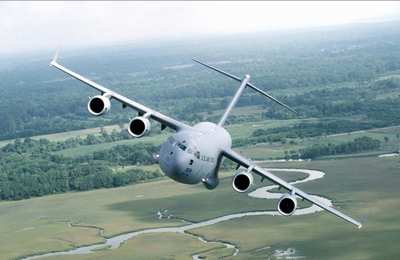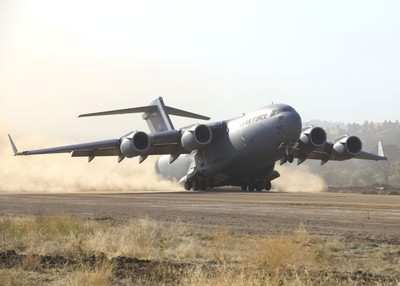Four-Phase Program Hopes To Add To Freighters Capability
The USAF's C-17 Integrated Test Force at Edwards Air Force Base,
CA is in the midst of a four-phase test program to chart the
aircraft's takeoff and landing performance on non-paved
surfaces.

Engineers and pilots are testing the aircraft in extreme runway
conditions to eventually write the book for landing on dirt runways
during dry, wet, and muddy runway conditions.
Phase 2 is scheduled to get under way December 4. It follows
lessons learned from flight tests conducted during Phase 1, which
occurred between September 16 and November 8 at Fort Hunter
Liggett, CA.
According to Lieutenant Colonel Bob Poremski, C-17 Integrated
Test Force director, the first phase validated the jet's ability to
bring a large force into an airfield without making runway
condition corrections.
Testing at Fort Hunter Liggett started with charting performance
on an unprepared, dry landing zone according to Poremski. Once
completed, the team added water to the surface approximating
differing amounts of rainfall.
Successful testing should allow deployment of the aircraft
closer to the combat zone cutting transit times.
"The C-17 was designed to deliver forces and cargo from an
initial pick-up point directly to the battlefield. This is called
the direct-delivery concept," said Poremski, but original testing
of the aircraft didn't include unimproved surfaces. "Our testing is
expanding the types of surfaces the C-17 can operate in and out
safely."

Performing tests on wet, semi-prepared runways proved to be a
challenge, said Gus Christou, a mechanical subsystems engineer with
Edwards' 418th Flight Test Squadron.
"The biggest concern we had was executing this test on a
relatively short runway," Mr. Christou said. "Most of the runways,
with the exception of the Edwards runway, are 5,800-feet long. For
the wet-testing we proposed in the test plan, we really didn't have
enough room to execute on a fully-wetted runway. So, we split the
runway into a partial wet section and a partial dry section to
ensure the aircraft could perform stopping as well as takeoff
(again)."
There also was a computer modeling issue. Mr. Christou said the
performance software that currently is available for the aircraft
addresses both take offs and landings on wet and dry conditions for
ordinary concrete runways. However, in this particular case there
is a mixed condition runway.
"The software cannot predict performance of the airplane on a
combination of dry and wet runways," he said. "That existing
software had to be blended to accommodate a dry and wet runway. It
was very time-consuming."

Testing at Fort Hunter Liggett eventually validated the upgraded
software models; by the end of testing it was able to accurately
predict aircraft performance.
"But it's quite a spectacular site to see this huge cloud of
dust chasing you when you're taking off, and then the same thing
happening when you're landing -- a dust cloud chasing you as you
come to a stop," Mr. Christou said.
The dust clouds and wet dirt that arose from takeoffs and
landings added some unusual aspects to the testing process.
"Through semi-prepared runway operations testing and weighing
the aircraft after the take-offs and landings, we've seen anywhere
from 1,200 to 1,500 additional pounds of dirt collected in the
aircraft," noted Poremski. "We've seen enough dirt collect in the
wheel wells to where it was eight to 10 inches in depth.
Maintenance is also an issue. Crews used fire hoses to get the
mud off the aircraft. Instrumentation temporarily mounted to the
landing became "semi-permanent" because of the dried mud.
The third and fourth phases are scheduled to take place at Fort
Chaffee, AR, and Fort McCoy, WI next year. Officials say all four
phases of testing should be complete by November 2007.
ANN Salutes Technical Sergeant Eric M. Grill of 95th Air
Base Wing Public Affairs.
 Airborne 11.24.25: ANN's 30th!, Starships V3 Booster Boom, Earhart Records
Airborne 11.24.25: ANN's 30th!, Starships V3 Booster Boom, Earhart Records ANN FAQ: Submit a News Story!
ANN FAQ: Submit a News Story! Classic Aero-TV: DeltaHawk Aero Engine Defies Convention
Classic Aero-TV: DeltaHawk Aero Engine Defies Convention NTSB Final Report: Glasair GlaStar
NTSB Final Report: Glasair GlaStar ANN's Daily Aero-Term (11.22.25): Remote Communications Outlet (RCO)
ANN's Daily Aero-Term (11.22.25): Remote Communications Outlet (RCO)





